More languages
More actions
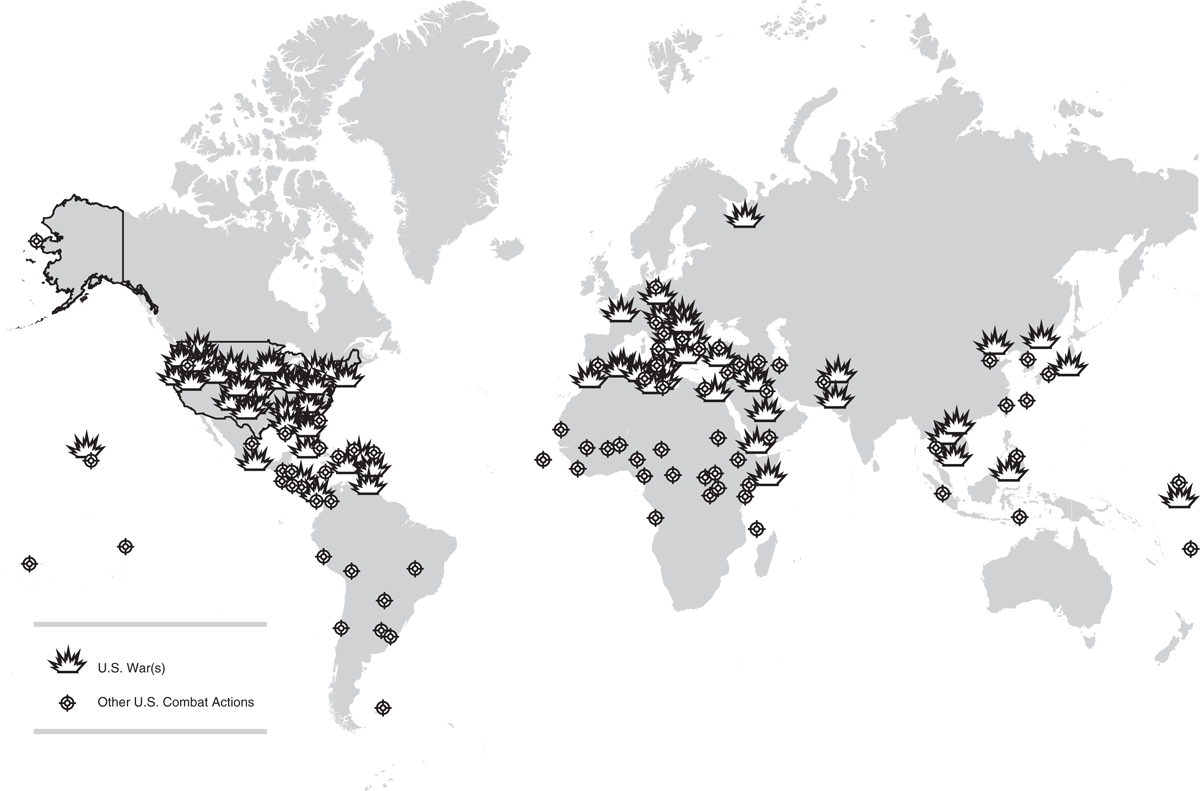
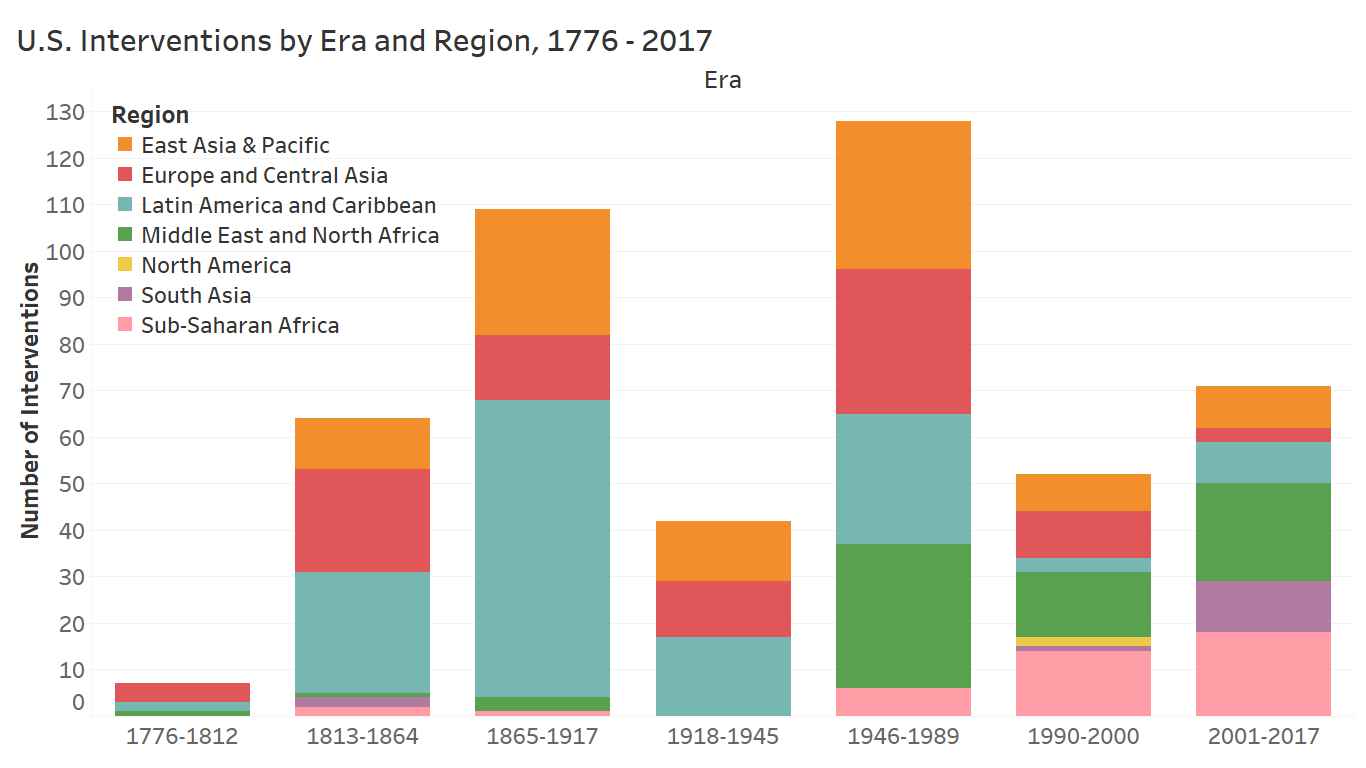
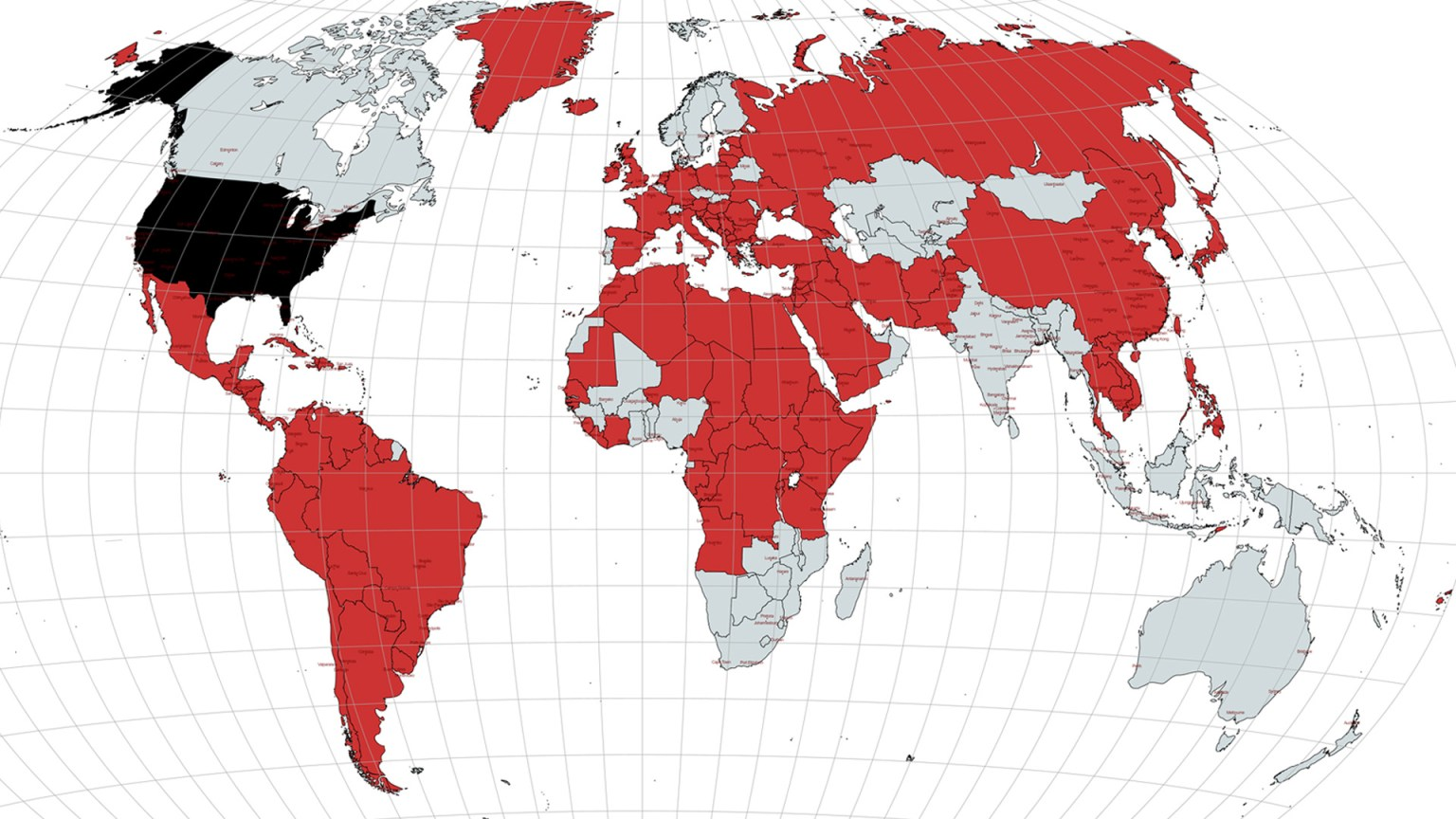
United States imperialism consists of policies aimed at extending the economic, political, cultural and military influence of the United States of America over areas beyond its boundaries, especially considering the Marxist definition of imperialism as originally defined by Lenin, but other aspects of imperialism as well, such as military operations and economic terrorism.
Doctrines followed (and sometimes proposed by the U.S. government itself since its inception) such as Manifest Destiny, the Monroe Doctrine, the Roosevelt Corollary, the Big Stick, the Wolfowitz Doctrine, the National Security Doctrine, etc. and events such as the conquest of the west, the Mexican war, the banana wars, the Spanish-Cuban-Statesian war and, more recently, the Vietnam War, the U.S. blockade against Cuba, the war in Afghanistan, etc. have made "American imperialism" a term accepted by the greater part of the international community.
The United States has interfered in the elections of 45 foreign countries[1] and organized over 132 CIA and military interventions around the world since 1890,[2] in addition to almost 100 before 1890.[3]
History
Between 1798 and 1827, the United States participated 23 military interventions, including in Greece, Libya, and Cuba. It did 71 interventions between 1831 and 1896 on all continents except Antarctica. The U.S. did 40 interventions between 1898 and 1919.[3]
According to a report by the Congressional Research Service, a US government institution that compiles information on behalf of Congress, the United States launched at least 251 military interventions between 1991 and 2022. The report documented another 218 US military interventions between 1798 and 1990. This adds up to a total of 469 US military interventions since 1798 that have been acknowledged by the Congress. Of the total 469 documented foreign military interventions, the Congressional Research Service noted that the US government only formally declared war 11 times, in just five separate wars.[4] In an analysis of the report, journalist Benjamin Norton noted that the data excludes the independence war been US settlers and the British empire, any military deployments between 1776 and 1798, excludes the deployment of the US military forces against Indigenous peoples, when they were systematically ethnically cleansed in the violent process of westward settler-colonial expansion, and the US Civil War, and further noted that all of these numbers are conservative estimates, because they do not include US special operations, covert actions, or domestic deployments.[5]
Early history
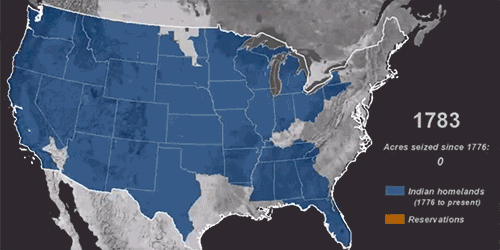
In its early existence, the United States was focused on settler-colonial expansion across the North American continent through acts of genocide against the indigenous North American people, in order to secure ever-increasing amounts of territory and natural resources for the Euro-American settlers. Accompanying this process was the U.S. involvement in and perpetuation of the Atlantic slave trade, a lengthy period in which enslaved African peoples were brought to the Americas to be used and exchanged as property by Euro-American settlers in order to work on the lands which were being methodically wrested from the indigenous population.
In 1898, under the guise of helping Cuba gain independence, U.S. imperialism invaded and seized control of Cuba from Spain. It seized other Spanish colonies as well, including Puerto Rico, Guam, and the Philippines during the same offensive.[6]
First World War
See main article: First World War
The United States occupied Cuba from 1906 to 1909, in 1912, and from 1917 to 1922. It occupied the Dominican Republic in 1903, 1904, and 1914 and from 1916 to 1924; Haiti from 1915 to 1934; Honduras in 1903, 1907, 1911, 1912, 1919, 1920, 1924, and 1925; Nicaragua from 1909 to 1910 and 1912 to 1933; Guatemala in 1920; Costa Rica in 1921; and El Salvador in 1932. In 1920, Franklin Roosevelt said that the USA controlled the votes of all six Central American countries in the proposed League of Nations.[7]
Second World War
See main article: Second World War
While functioning as a military ally of the Soviet Union and providing equipment and funds, the United States and Britain refused the opening of a military front in Western Europe that would have helped the Soviet Union by forcing Hitler to divert and divide his troops, tanks, and planes. Instead, the United States and Britain opened an offensive in Africa and Asia, where the colonies were. The United States was the only major capitalist power to emerge undamaged from the Second World War, and it became the leader of world capitalism.[6]
Cold War
See main article: Cold War
Following the Second World War, the United States set out to create a worldwide imperialist united front to defeat the forces of communism and socialism that had taken state power in numerous countries and sought to place world capitalism under its own hegemonic leadership. Instead of punishing Axis powers Japan and Germany after the war, the United States planned to revive their economies and restore the political power of the defeated elites in both countries. The United States occupied Japan and Germany militarily, turning them into bulwarks in a global anti-communist, anti-Soviet front.
In 1949, the United States created NATO which grouped all of the imperialist countries of Europe together under the Pentagon’s leadership. The United States extended this new system of anti-communist alliances during the Eisenhower administration (1953-1961) with the creation of SEATO for Southeast Asia (1954) and the Baghdad Pact (CENTO) for the Middle East (1955).
Once the Soviet Union had successfully developed its own nuclear weapons program and had, at great economic and social cost to its socialist economy, reached some degree of military equality with the United States, the United States opted for an alternative strategy that it labeled "containment." While containment implied a defensive strategy, in reality this was really a non-stop war against the national liberation movements and a policy of subversion inside the socialist countries. The United States treated every genuine national liberation movement as a potential ally of the USSR. They carried out a multitude of covert wars and other actions to prevent national liberation movements from succeeding and to maintain U.S. hegemony.[6]
In her 1962 book Cash and Violence in Laos and Vietnam, Anna Louise Strong described U.S. imperialist expansion into the Pacific after the Second World War as falling into three stages:
America’s expansion in force into the southwest Pacific began with the defeat of Japan in the second world war. One may note three stages, each taking about five years. In the first stage, in the 1940s, the U.S. took over the Japanese island bases and absorbed properties of Britain and France, its war-time allies. In the second stage, after the rise in 1949 of the Chinese People’s Republic, USSR did not even take back all the territory lost by the Russian tsar in the first world war, while America, by taking the island bases and by the growth of her air and naval power, turned both the Atlantic and Pacific into “American Lakes.” [...] The third stage began with the Geneva Agreements of 1954, which speeded Washington’s take-over of French interests in French Indo-China.[8]
The concept of transforming the Pacific ocean into a "lake" via U.S. dominance of the region, in order to create a "vast moat" to protect the U.S. from its enemies, particularly China, is also referenced in a 1951 speech to U.S. Congress by General Douglas MacArthur.[9]
Strong also explained how the containment policy of the Cold War seamlessly turned into a rationale for crushing any movement against U.S. imperialism by labelling their resistance and desires for sovereignty as communist, saying of the Cold War in 1962 that it "has grown from fever to frenzy, so that to outlaw Communists is proper, to 'contain' Communists by jail or armed cordon is basic strategy, and to kill Communists a holy deed. From this it is a slight step to call any dark-skinned peasants 'Communists' if they refuse to give their country's independence with both hands to America for a military base."[8]
1991–present
Since the fall of the Soviet Union, the United States has been engaged in constant war, and now has a bipartisan military outlook based on permanent war. For example, in 1992, Paul Wolfowitz, then the U.S. undersecretary of defense policy, supervised the drafting of a strategic document for the post Cold War world. It was written as a strictly internal document, and proclaims that "Our first objective is to prevent the re-emergence of a new rival" and says that "First the U.S. must show the leadership necessary to establish and protect a new order that holds the promise of convincing potential competitors that they need not aspire to a greater role or pursue a more aggressive posture to protect their legitimate interests. Second, in the non-defense areas, we must account sufficiently for the interests of the advanced industrial nations to discourage them from challenging our leadership or seeking to overturn the established political and economic order. Finally, we must maintain the mechanisms for deterring potential competitors from even aspiring to a larger regional or global role." The document stressed that it was important to convey "the sense that the world order is ultimately backed by the U.S." The document explicitly broke with the concept of containment, and instead advocated that the U.S. should use its unrivaled military to preemptively attack and overthrow "rogue states" that "could seriously unsettle international relations."[10]
The overthrow of the Soviet Union and Eastern European socialist countries created a windfall of profit for Western banks and corporations, as they rushed in to privatize these countries' previously socialized property. Additionally, immediately after the fall of the Soviet Union the U.S. attacked Iraq, and then in the Clinton years Somalia, Sudan, Haiti, and Yugoslavia. After launching a war against Afghanistan in 2001, Bush declared an "Axis of Evil" consisting of Iraq, Iran and DPRK, a list of targets for further regime change efforts. Months later Undersecretary of State John Bolton listed Syria, Libya, and Cuba as additional "rogue states" to be targeted. In 2011, the United States led the NATO alliance to carry out a massive bombing war in Libya.[6]
An article published by Liberation School observes that "While the political style of Bush and Obama [and Trump] could not be more different, this hit list has generally been consistent from one administration to the next. Washington has used a combination of economic warfare, subterfuge, and direct military aggression to pursue regime change."[10]
Death toll
See also: List of atrocities committed by the United States of America
Austin Murphy estimates that U.S. imperialism and colonialism have intentionally killed over 11 million unarmed civilians, including five million indigenous people, a million Filipinos, 500,000 German and Japanese people, over 500,000 Indonesians, over a million each of Vietnamese, Iraqis, and Koreans, and over 500,000 Cambodians. This is a low estimate and Murphy acknowledges that the deaths of indigenous people in North America alone is over 18 million.[11]
Military bases
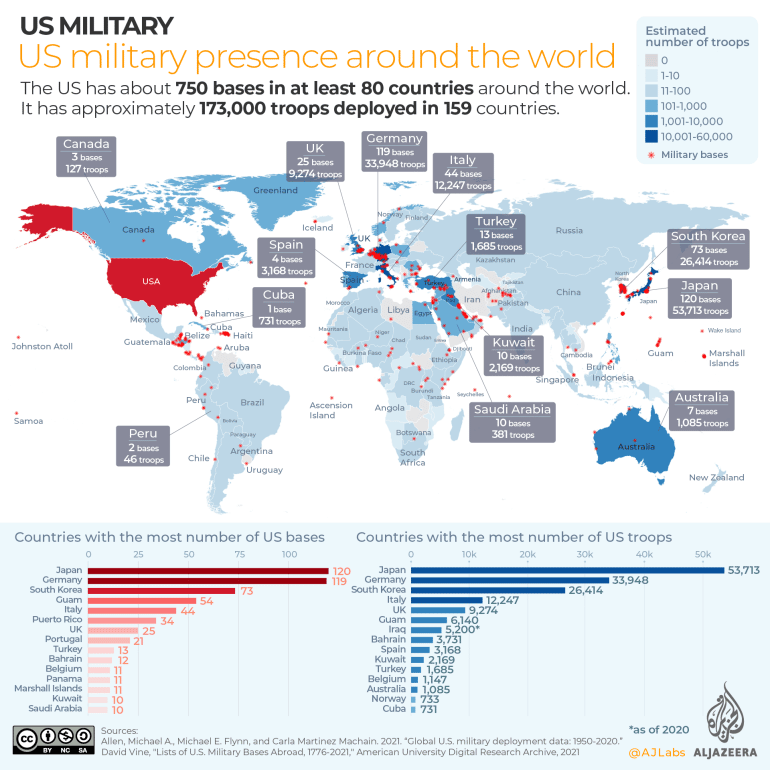
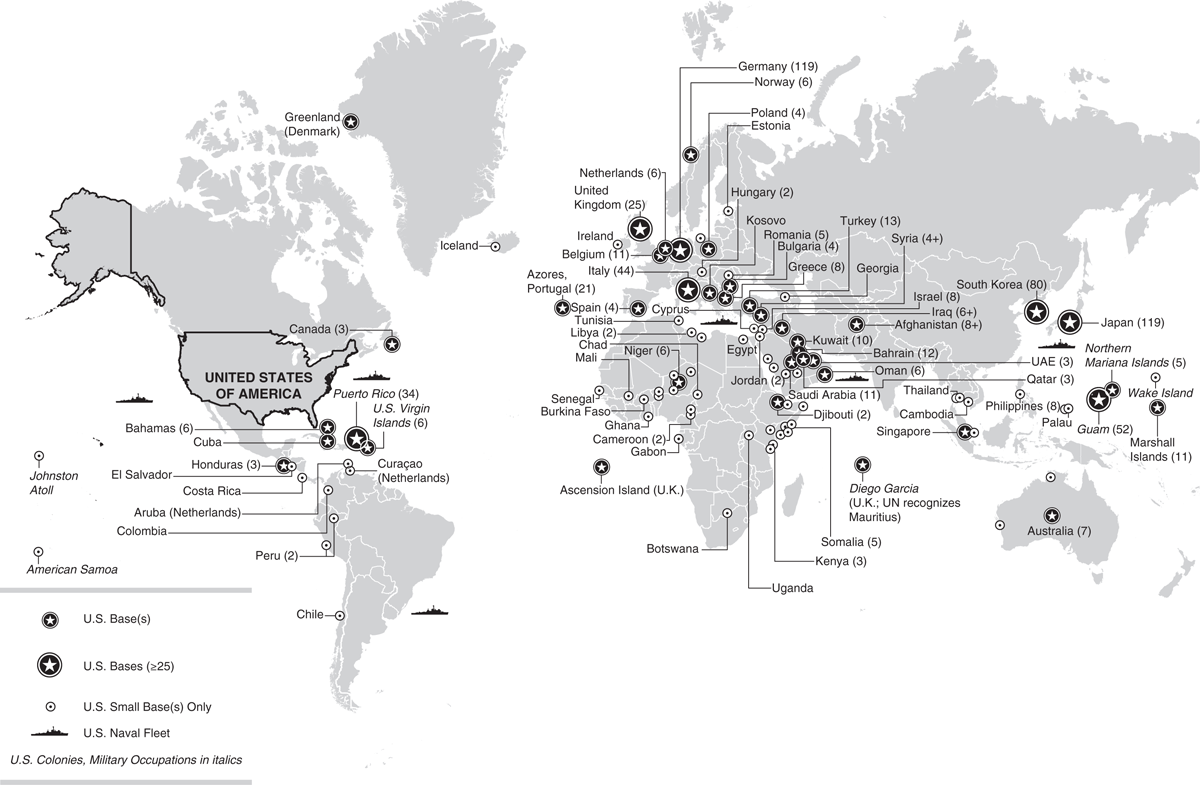
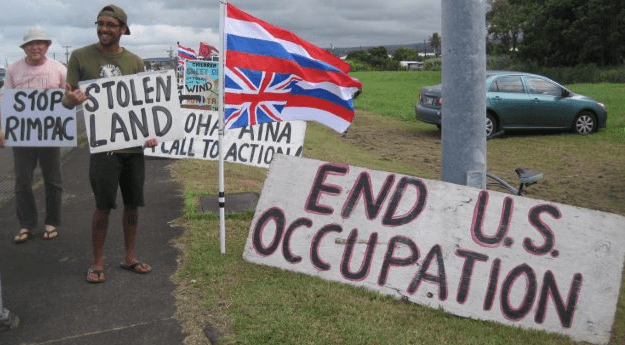
The United States has 750 military bases around the world in at least 80 countries. It also has 173,000 troops deployed in foreign countries. The country with the most U.S. military presence besides the U.S. itself is Japan, with 120 bases and over 53,000 troops. Japan is followed by Germany and then south Korea.[12]
During the Second World War, the USA relied mainly on local workers to build its bases and worked for as low as 10 cents per day or were paid in food rations. The Navy built 288 bases in the Atlantic Ocean, 195 in the Pacific, and 11 in the Indian Ocean.[13]
In addition to having bases and troops in South Korea, the U.S. military has maintained command over the South Korean military since the Korean War in the 1950s. South Korea has operational control of its military under armistice conditions, but the United States would take over in wartime, and the U.S. combatant commander would be able to direct, organize, employ, assign command functions to, or suspend the duty of subordinate South Korean commanders and forces. In essence, if war breaks out on the Korean Peninsula, South Korea would supply the overwhelming majority of the fighting force, which would then be placed under U.S. operational control.[14][15][16]
Anti-base and U.S. military withdrawal movements
In places where U.S. troops are stationed, numerous controversies have arisen due to the many crimes and incidents of misconduct of U.S. personnel as well as the environmental pollution generated by U.S. bases, as well as the erosion of national sovereignty that occurs with the U.S. military presence in host countries, and the international provocations and tensions that occur when countries collaborate with US military exercises. The anti-base movement seeks the withdrawal of U.S. troops and removal of U.S. bases from the many territories they occupy.
Okinawa in Japan is a prominent example of anti-base activism and sentiment. Although Okinawa makes up less than 1% of Japan's land area, it contains three-quarters of the U.S. military bases in Japan and 30,000 U.S. soldiers[17] and has seen tens of thousands of citizens protesting against the presence of U.S. bases there.[18] The struggle in Okinawa represents only one facet of the larger global struggle against U.S. bases but provides an illustrative example of the issues faced by people living in US-occupied territory.
The crimes of U.S. military personnel and U.S. civilian contractors working in base areas include numerous killings and sexual assault crimes committed against the citizens of the countries where they are stationed. In mainland Japan and overseas, people are aware of only a few of these crimes, notably the sexual assault of a 12-year-old girl by three U.S. service members in 1995 and the sexual assault and murder of a 20-year-old woman by a former Marine in 2016. However, members of Okinawa Women Act Against Military Violence have compiled an ongoing chronology of U.S. military sexual assaults of Okinawan women and have uncovered how the earliest attacks started soon after the U.S. invasion of Okinawa in 1945 and have continued unabated to the present day. The total number of victims runs into the hundreds, but the organization's co-chair Suzuyo Takazato, quoted in a 2021 article, says many cases remain hidden. According to Takazato, "Both the U.S. and Japanese governments want to minimize people’s awareness of the number of crimes committed by U.S. service members on Okinawa. They think if this information becomes public, it will harm U.S.-Japan relations."[19]
Many crimes have also been committed by U.S. military personnel against citizens in south Korea, another host of considerable US military presence. Notable incidents include the widely publicized brutal sexual assault and murder case of Yoon Geumi in 1992,[20] and the case of two young Korean girls were fatally struck by armored US military vehicles in 2002.[21]
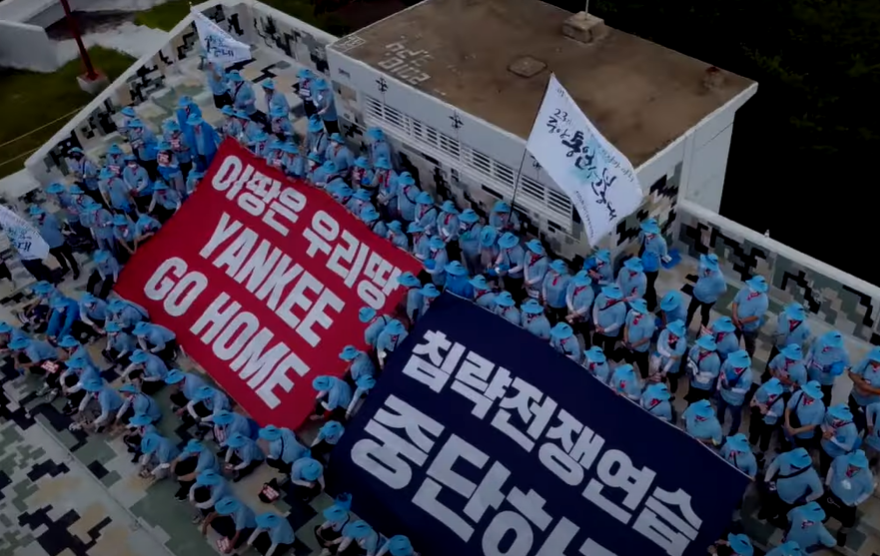
Kooni Firing Range in Maehyangri also highlights the hazards of hosting U.S. bases for south Koreans. Before the 2005 closure, residents fought for years to have the range shut down. The resistance movement gained momentum every time an errant bomb killed or injured a Maehyangri resident. Throughout Kooni's time in use, 10 people were killed and more were seriously injured in bombing accidents. In 1967, a pregnant woman lost her life after being hit by a bomb while digging for oysters. The following year, a group of five children was hit with a bomb while playing on the beach. Four of them died from their injuries. The U.S. Air Force made no known effort to clean up the countless bombs that were left after decades of practice drills. Used shells would disintegrate and bleed chemicals into the ground and water. In a study of soil in the area, the South Korean defense ministry found lead, cadmium and copper that exceeded permissible levels. In addition, the firing range was not public knowledge until 1988, the year of Korea's democratization. Before that, media coverage on the range was forbidden.[22]
Protests against U.S. military presence in Korea as well as against US-ROK military cooperation occur regularly among south Korea's citizens. For example, on August 13, 2022, thousands of south Korean unionists and their progressive supporters rallied to protest against joint US-south Korea war game exercises and U.S. military presence in south Korea. In an interview, demonstrator Lee Seung-Woo stated, "We not only oppose the war exercises, but we want the U.S. Forces Korea, which is actually controlling and interfering with the Korean peninsula to leave this land. We believe that only then will the eighty million Koreans from both north and south be able to live peacefully."[23]
Additionally, in South Korea, between the end of the Korean War and the early 1990s, more than one million Korean women were caught up in a state-controlled prostitution industry, in special zones surrounding U.S. bases licensed by the South Korean government, reserved exclusively for American troops, and monitored and policed by the U.S. Army. Lee Beom-gyun, a judge on an appellate court in Seoul, has agreed that the South Korean government actively encouraged prostitution to boost ties with the United States. Lee ruled that the Korean state “operated and managed” the military camp towns to contribute to the “maintenance of a military alliance essential for national security” and abetted the industry “through patriotic education praising prostitutes as ‘patriots who bring in foreign currency.’” Some estimates state that at the peak of U.S. troop strength in the 1980s, the U.S. base town prostitution economy contributed 5 percent of South Korea’s gross domestic product.[24]
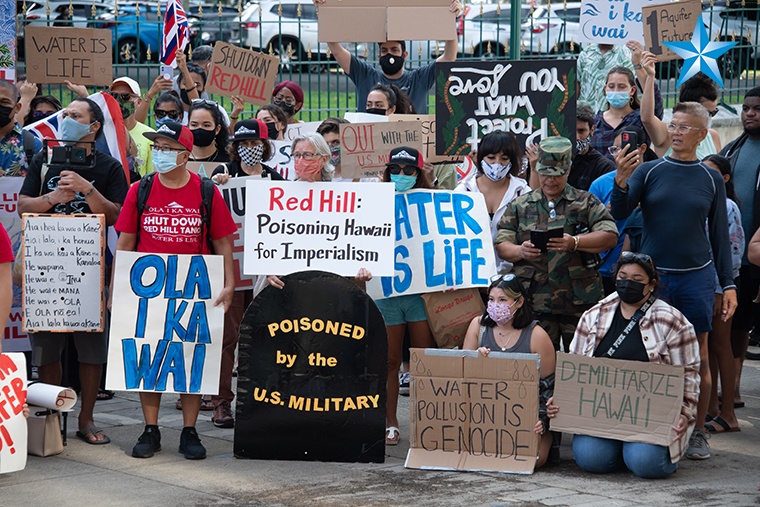
Throughout Oceania, there have been many movements to oppose the presence of U.S. military facilities. In Hawaii, the environmental degradation and resulting public health problems created by U.S. bases has been an ongoing issue. A notable case of this can be seen with the Red Hill Bulk Fuel Storage Facility, where a petroleum leak was found to have contaminated Honolulu's drinking water supply.[26] According to an article by Breakthrough News, the Navy claimed that the site of the polluting oil wells was critical for the "mission readiness" of the U.S. Indo-Pacific Command with what the US military has considered to be "increasing aggression" from Russia and China.[27] A 2022 article by the Honolulu Civil Beat states that the commander of the U.S. Pacific Fleet said Oahu residents had been right to believe Red Hill was unsafe, and that the results of two U.S. Pacific Fleet investigations into the disaster reveal that a leak on May 6 was much worse than was initially reported.[28]
Economic domination
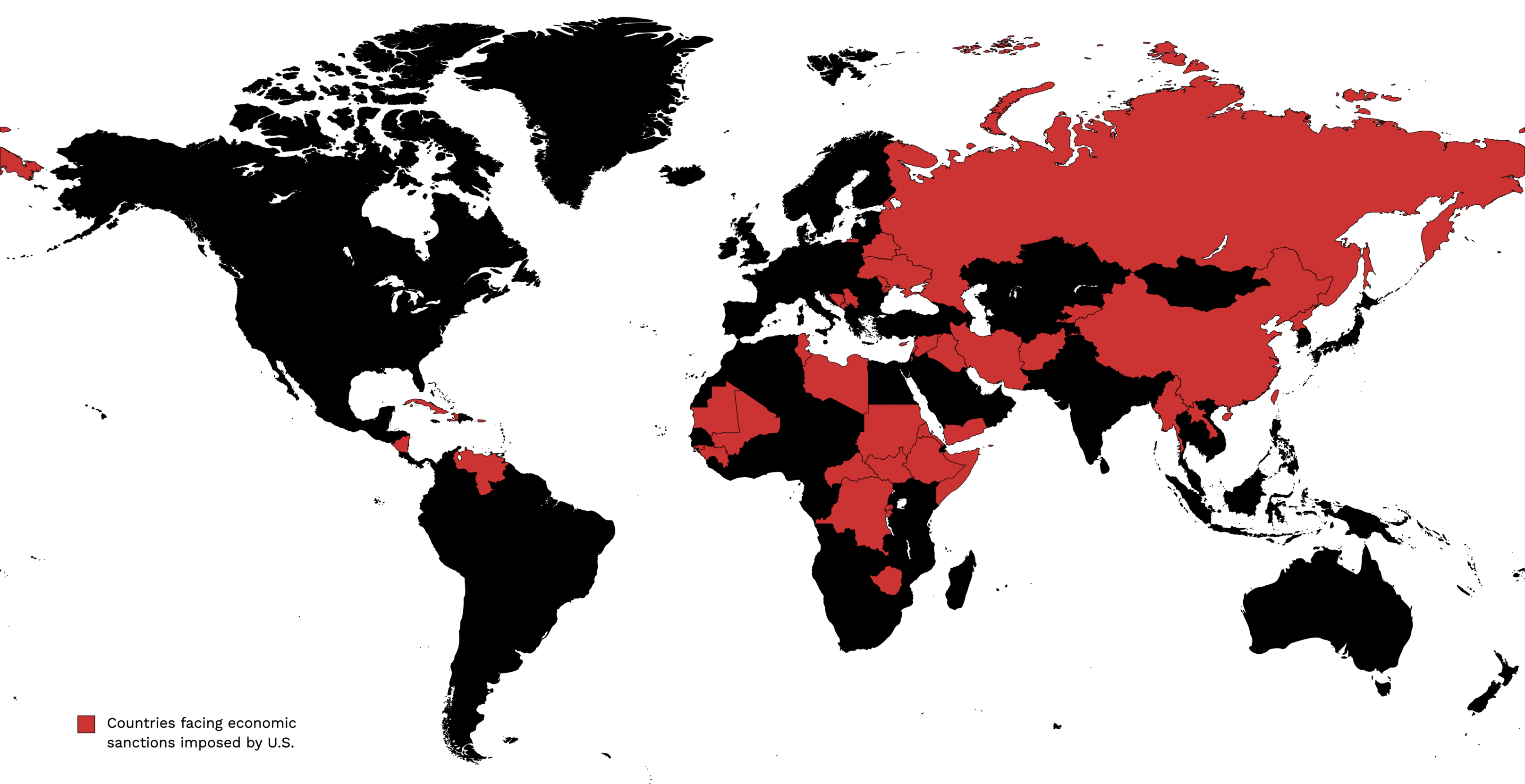
The United States bourgeoisie uses various economic methods to shape and control the development and economic policies of other nations and force them into subordination and perpetual debt and under-development. This can be seen through institutions such as the World Bank and the International Monetary Fund (IMF), institutions in which the U.S. plays a key role in managing. Economic sanctions are another major method by which the United States manipulates and destroys the economic development of other countries. Freezing or seizure of assets, often under the guise of sanctions, is another method commonly used by the United States to stifle and disrupt foreign economies and enrich its own by excluding its own companies and institutions from sanctions while freezing and confiscating the assets of the target country.[29][30][31]
World Bank
See main article: World Bank
Since its origin, the president of the World Bank has been a US citizen proposed by its government. The US is also the only country to have a de facto right of veto at the World Bank, which is headquartered in Washington, D.C.[32] Countries must also join the International Monetary Fund to be eligible to join the World Bank Group.[33]
Historian and political scientist Eric Toussaint asserts that the unstated agenda of the World Bank is to "subordinate the public and private spheres of all human societies to the capitalist imperative of seeking maximum profit" which results in stagnation and deterioration of the living conditions of a great majority of the world’s population, concurrently with greater and greater concentration of wealth, as well as contributing to the deterioration of the natural environment.[34]
International Monetary Fund
See main article: International Monetary Fund
According to a 2016 article by the Center for Economic and Policy Research (CEPR) regarding voting shares in the IMF, the U.S. "dwarfs all other member countries’ voting shares" and the CEPR's co-director stated that "IMF governance structure [...] ensures that the U.S. and Europe will continue to control the Fund."[35]
Former IMF senior economist Davison Budhoo wrote that through extensive and systematic statistical fraud the IMF imposes its policies on developing countries. He explained that the IMF "manipulated, blatantly and systematically, certain key statistical indices so as to put ourselves in a position where we could make very false pronouncements about economic and financial performance" and that the consequences of these policies led to massive poverty and starvation, noting that the IMF's policies are made in "utter disregard to local conditions" and lead countries to "self destruct" and "unleash unstoppable economic and social chaos". He also stated that the routine policy packages of the IMF "can never serve, under any set of circumstances, the cause of financial balance and economic growth" and "can only serve to accentuate world tensions, expand even further the already bulging ranks of the poverty-stricken and destitute of the South".[36]
During the 1980s and 90s, the IMF dramatically expanded its reach by making assistance conditional on borrowers committing to extensive market reforms. During what are known as the Third World Debt Crisis, the Asian Financial Crisis of 1997–98, and the collapse of the Soviet Union, the IMF exercised enormous pressure on states in receipt of loans, demanding they commit to austerity and major transformations of their domestic economies. Failing to agree to these terms not only jeopardized the IMF’s assistance; it also jeopardized access to other sources of foreign capital, since the existence of a prior arrangement with the IMF was used by other lenders to determine a country’s creditworthiness. It is by this method that the IMF brings countries into subordination under U.S. dominance. Although the IMF's policies are certainly heavily influenced by neoliberalism, they are also an extension of older colonial and imperialist methods of domination that can be traced back to long before the 1980s and 90s.[37]
Economic sanctions
See main article: Economic sanctions
According to Sanctions Kill in a 2021 article, US sanctions affect a third of humanity with more than 8,000 measures impacting more than 40 countries and that the U.S. far exceeds any other country in the number of countries they have strangled with economic sanctions.[38] Lauren Smith notes in Monthly Review Online that it is not unilateral sanctions imposed by the U.S. alone that devastate a targeted country, it is the imposition of secondary sanctions upon foreign third parties that represents the final blow to its economy and people. These measures threaten to cut off foreign countries, governments, companies, financial institutions and individuals from the U.S. financial system if they engage in prohibited transactions with a sanctioned target—irrespective as to whether or not that activity impacts the United States directly.[29]
In an internal memo regarding Cuba, U.S. officials discussed how imposing "economic dissatisfaction and hardship" on Cuba would be an effective means of deposing the communist government, stating that because Castro enjoyed majority support among the people, their only option to reduce support for him would be "to bring about hunger, desperation and overthrow of government" by "denying money and supplies to Cuba, to decrease monetary and real wages".[39] The US embargo of Cuba is one of the oldest and strictest of all US sanctions regimes, prohibiting nearly all trade, travel, and financial transactions since the early 1960s.[31]
Freezing and seizure of assets
Russian Foreign Minister Sergey Lavrov claims that the U.S. simply confiscates Venezuela’s money under the guise of sanctions, noting that the U.S. is experienced in such illegal affairs, giving Iraq, Libya, Iran, Cuba, Nicaragua, and Panama as examples. According to Lavrov, "US companies operating in Venezuela are excluded from the sanctions regime. Simply put they want to overthrow the government and gain profits at the same time."[30]
In 2003, President Bush signed an order to take possession of the Iraqi government assets that were frozen in 1990, before the Persian Gulf War. As a result, seventeen of the world’s biggest financial institutions were told by the Treasury Department to hand over $1.7 billion in frozen Iraqi assets that the U.S. government intended to place in an account at the NY Fed.[29]
In 2015, it was announced that $67 billion in Libya’s assets remained frozen from 2011. In 2018, it was announced that Libya’s assets had decreased to $34 billion. The UN Libya Experts Panel is “looking for answers” to explain the disappearance of $33 billion in frozen assets.[29]
Since 2021, the U.S. Biden administration has blocked Afghanistan’s central bank from accessing roughly $7 billion in its foreign reserves held in the US. Along with sanctions on government officials and a cutoff of aid, this has contributed to a severe collapse of Afghanistan’s economy.[31]
Unconventional and covert warfare
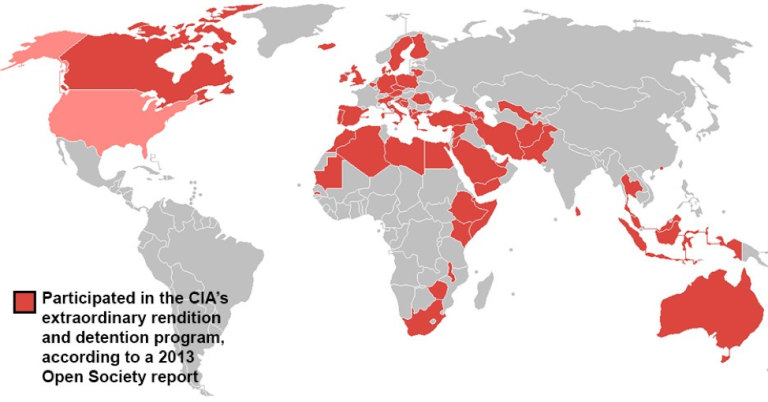
Unconventional warfare consists of military and quasi-military operations other than conventional warfare, and may use covert forces, subversion, or guerrilla warfare. This is typically done to avoid escalation into conventional warfare as well as international conventions. Covert or unconventional warfare may be conducted to enable a resistance movement or insurgency to coerce, disrupt, or overthrow a government or occupying power by operating through or with an underground, auxiliary, and guerrilla force. Unconventional means are regularly used in service of the U.S.'s primary strategies against revolutionary, anti-imperialist, and communist influence, which include "containment" (preventing the spread of communism and communist influence) and "rollback" (forcing a change in the major policies of a state, usually by regime change).
In Afghanistan, the Carter administration began providing covert military assistance to Afghanistan's Mujahideen in an effort to drive the Soviets out of the nation and to raise the military and political cost of Soviet presence in Afghanistan.
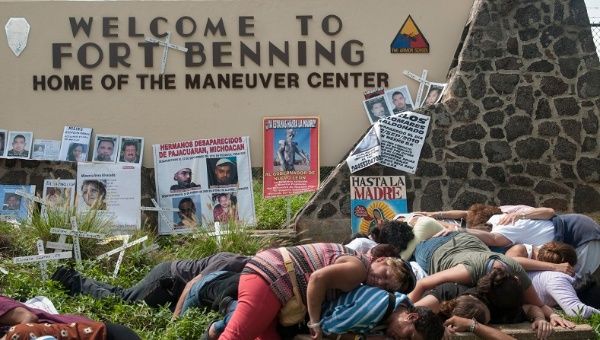
Under the Reagan Doctrine and the regime-change policy of rollback, the United States provided overt and covert aid to anti-communist guerrillas and resistance movements in an effort to "roll back" anti-imperialist governments in Africa, Asia, and Latin America. The doctrine was part of the administration's overall strategy to win the Cold War, after the policy of containment was deemed insufficient and that "rollback" of revolutionary governments was necessary. Neoconservative Jeane Kirkpatrick argued in 1979 that Third World revolutions were illegitimate and the products of Soviet expansion, an example of a common justification for the rollback strategy. According to political analysts Thomas Bodenheimer and Robert Gould, "it was the Heritage Foundation that translated theory into concrete policy. Heritage targeted nine nations for rollback: Afghanistan, Angola, Cambodia, Ethiopia, Iran, Laos, Libya, Nicaragua, and Vietnam".[41]
For instance, the U.S. supported the Contras in Nicaragua as part of the rollback strategy. From an early stage, the rebels received financial and military support from the United States government, and their military significance decisively depended on it. After US support was banned by Congress, the Reagan administration covertly continued it. These illegal activities culminated in the Iran–Contra affair, in which U.S. senior administration officials secretly facilitated the sale of arms to Iran, hoping to use the proceeds of the arms sale to fund the right-wing Contras in Nicaragua.
Information and psychological operations
See also: Central Intelligence Agency, Operation Mockingbird, CIA influence on public opinion
The United States uses a multitude of tactics in controlling the flow of information in order to achieve its political warfare goals, through numerous agencies, agents, and front organizations such as many NGOs and broadcasting organizations. These propaganda campaigns are directed at both the U.S. public as well as internationally. These operations provide support for the military and economic goals of the U.S. and help the U.S. stoke and conduct color revolutions to overthrow foreign governments.
Mass surveillance
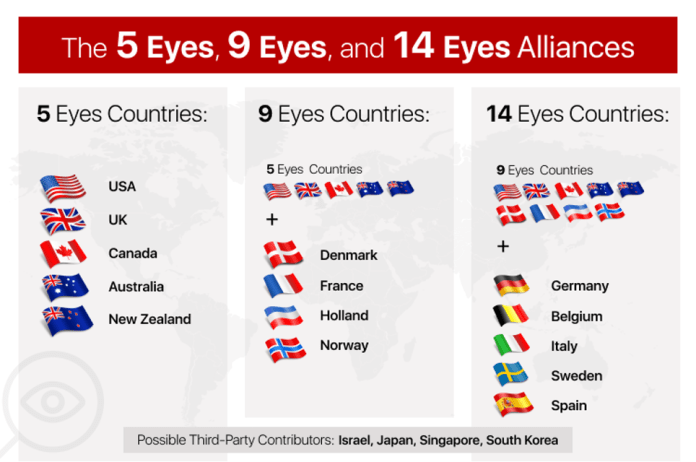
The U.S. National Security Agency is involved in mass surveillance programs targeting the Danish, Dutch, French, German, Norwegian, and Swedish populations,[42] while the CIA spies on the Statesian and international populations through phones, computers, and TVs.[43]
By country
Afghanistan
See also: Economic sanctions#Afghanistan
Angola
In November 1975, the CIA and apartheid South Africa invaded Angola when it became independent from Portugal. Fidel Castro deployed 350,000 Cubans in Angola who fought until 1989 and defeated the white supremacist forces.[44]
Former CIA case officer John Stockwell was in charge of managing the Angola covert action, which he ran from his office in Washington. Later, in a 1983 interview, Stockwell described the process by which the CIA created "totally false" atrocity propaganda about the situation in Angola, as well as about the Cuban involvement:
Interviewer: Well, give me a concrete example of how you used the press this way, how a false story is planted and how you got it published?
Stockwell: Well for example, in my war, the Angola war, that I helped to manage, one third of my staff was propaganda. Ironically it's called "covert action" inside the CIA. Outside, that means the violent part. I had propagandists all over the world, principally in London, Kinshasa, and Zambia. We would take stories which we would write and put them in the Zambia Times, and then pulled them out and sent them to a journalist on our payroll in Europe. But his cover story, you see, would be what he had gotten from his stringer in Lusaka, who had gotten them from the Zambia Times. We had the complicity of the government of Zambia, Kenneth Kaunda if you will, to put these false stories into his newspapers. But after that point, the journalists, Reuters and AFP, the management was not witting of it. Now, our contact man in Europe was. And we pumped just dozens of stories about Cuban atrocities, Cuban rapists--in one case we had the Cuban rapists caught and tried by the Ovimbundu maidens who had been their victims, and then we ran photographs that made almost every newspaper in the country of the Cubans being executed by the Ovimbundu women who supposedly had been their victims.
Interviewer: These were fake photos?
Stockwell: Oh, absolutely. We didn't know of one single atrocity committed by the Cubans. It was pure, raw, false propaganda to create an illusion of communists, you know eating babies for breakfast and the sort. Totally false propaganda.[45]
Brazil
The 1964 Brazilian coup d'état (Portuguese: Golpe de estado no Brasil em 1964), colloquially known in Brazil as the Coup of 64 (Golpe de 64), was a series of events in Brazil from March 31 to April 1 that led to the overthrow of President João Goulart by members of the Brazilian Armed Forces, supported by the United States government.[46][41][47]
A 1962 referendum supported Goulart for president by a wide margin of 4 to 1. The United States opposed Goulart because of his pro-labor and nationalist leanings; Goulart passed a law limiting the amount of profits multinationals could transmit out of Brazil. President Kennedy stated that he would not be opposed to the overthrow of Goulart. In the 1962 congressional elections, the CIA funded about 850 anti-Goulart candidates to run for state and federal offices, spending between $12 and $20 million. The CIA carried out a constant and vicious propaganda campaign against the Goulart government, including the financing of a right-wing newspaper chain. U.S. ambassador Lincoln Gordon met frequently with Goulart's right-wing enemies, and U.S. military attaché Vernon Walters cultivated his friend Gen. Humberto Castelo Branco for a military coup. The CIA organized anti-Goulart labor unions, and many anti-Goulart military officers were trained in the United States. Major U.S. military assistance programs influenced much of the Brazilian army to oppose Goulart. On March 31, 1964, the coup took place. Castelo Branco instituted a military dictatorship with many arrests, tortures, disappearances, and death squads.[41]
Cambodia
Chile
Two months prior to the election of the socialist Salvador Allende as president of Chile in November 1970, the U.S. ambassador to Chile, Edward M. Korry, sent a message to National Security Advisor Henry Kissinger and another Department of State official stating that the preferred candidate of the U.S. should know that "not a nut or bolt will be allowed to reach a Chile under Allende" and that "Once Allende comes to power, we shall do all within our power to condemn Chile and the Chileans to utmost deprivation and poverty".[48]
After Allende won the election, the U.S. Ambassador repeatedly met secretly with the opposition candidate, Eduardo Frei Montalva, to urge him to annul the election. The CIA pursued a more forceful set of operations to pressure Frei. The political action program had "only one purpose," CIA Director Richard Helms told the National Security Council, "to induce President Frei to prevent Allende's election by the Congress on 24 October, and, failing that, to support—by benevolent neutrality at the least and conspiratorial benediction at the most—a military coup which would prevent Allende from taking office."[49][50] The CIA's extensive efforts to promote a military coup in Chile, known as Track II, were revealed by the U.S. Senate Select Committee led by Senator Frank Church in the mid-1970s.[49]
A 2007 article published by NACLA describes the "triad" of the imperialist U.S. policy toward Chile under Allende, which consisted of covert action, public policy, and economic policy being used together to promote their agenda and stir up the conditions for a coup:
CIA operations constituted the covert leg of what U.S. officials called "a triad" of policy approaches to Chile. The public approach, according to National Security Decision Memorandum 93 titled "Policy Toward Chile," was defined as a "correct but cool" diplomatic posture. Overt hostility, cautioned recently declassified SECRET/SENSITIVE strategy papers prepared for Henry Kissinger on the day of Allende's inauguration, would "serve Allende's purpose of rallying the Chilean people around him in the face of the 'foreign devil.' " The third leg of U.S. policy has come to be known as the "invisible blockade" of loans and credits to Chile. For years historians have debated if such a blockade existed, or whether Allende's socialist economic policies led to a loss of economic credit. Recently declassified NSC records on Chile show conclusively that the Nixon Administration moved quickly to shut down multilateral and bilateral foreign aid to Chile—before Allende had completed a month in office.[49]
The article further explains that at the World Bank, U.S. officials worked behind the scenes to assure that Chile would be disqualified for a pending $21 million livestock-improvement credit and future loans. Unable to simply veto loans, the State Department's Bureau of Inter-American Affairs prepared a series of questions for a World Bank delegation to pose to authorities in Santiago in an effort to show that Allende's economic policies did not meet criteria for credits. In addition, the president of the Export-Import Bank agreed to "cooperate fully" with Assistant Secretary of State for Inter-American Affairs Charles Meyer on the discontinuation of new credits and guarantees to Chile.[49]
As president, Allende sought to nationalize major industries, expand education and improve the living standards of the working class. He clashed with the right-wing parties that controlled Congress and with the judiciary. On 11 September 1973, the military moved to oust Allende in a coup d'état supported by the CIA. As troops surrounded La Moneda Palace, he gave his last speech vowing not to resign. Later that day, Allende committed suicide.
Following Allende's death, General Augusto Pinochet refused to return authority to a civilian government, and Chile was later ruled by a military junta until 1990.
As part of an early covert propaganda effort to cast the new regime in a positive light, the CIA provided $9,000 to, according to declassified documents, "cover travel costs for three Christian Democratic Party members to tour Latin America and Europe explaining their party’s decision to support the new Chilean government." The CIA also requested additional funds to help the Chilean Society for Industrial Development purchase a network of radio stations to use in promoting the new regime, and sought $160,000 to assist the near-bankrupt PDC to pay its bills and continue to function as Chile’s leading political party.[51]
In a 1976 Henry Kissinger met with Pinochet in Pinochet's office, prompted by a public controversy over the human rights abuses under Pinochet, as well under the pressure of the fallout of the Watergate scandal and the domestically unpopular Vietnam War. Trying to give Pinochet slack and let him know that the U.S. imperialists supported him, but needed to give him a public slap on the wrist, Kissinger stated to Pinochet:
In the United States, as you know, we are sympathetic with what you are trying to do here. I think that the previous government was headed toward Communism. We wish your government well. At the same time, we face massive domestic problems, in all branches of the government, especially Congress, but also in the Executive, over the issue of human rights. [...] But this is a problem which complicates our relationships and the efforts of those who are friends of Chile. I am going to speak about human rights this afternoon in the General Assembly. I delayed my statement until I could talk to you. I wanted you to understand my position. We want to deal in moral persuasion, not by legal sanctions. [...] In my statement, I will treat human rights in general terms, and human rights in a world context. [...] I will also call attention to the Cuba report and to the hypocrisy of some who call attention to human rights as a means of intervening in governments. I can do no less, without producing a reaction in the U.S. which would lead to legislative restrictions. The speech is not aimed at Chile. I wanted to tell you about this. [...] I want to see our relations and friendship improve. I encouraged the OAS to have its General Assembly here. I knew it would add prestige to Chile. I came for that reason. We have suggestions. We want to help, not undermine you. You did a great service to the West in overthrowing Allende. Otherwise Chile would have followed Cuba.[52]
Kissinger also stated that "It is unfortunate. We have been through Viet-Nam and Watergate. We have to wait until the elections. We welcomed the overthrow of the Communist-inclined government here. We are not out to weaken your position." Kissinger told Pinochet that "It would help you if you had some human rights progress, which could be announced in packages" saying earlier in the conversation that "If you could group the releases [of prisoners], instead of 20 a week, have a bigger program of releases, that would be better for the psychological impact of the releases" and that "if you could give us advanced information of your human rights efforts, we could use this". Kissinger clarified early in the conversation that "None of this is said with the hope of undermining your government. I want you to succeed and I want to retain the possibility of aid."[52]
Cuba
See also: United States embargo against Cuba, Bay of Pigs Invasion, Economic sanctions#Cuba
On March 17, 1960, President Eisenhower approved a CIA plan to arm and train Cuban exiles to overthrow Fidel Castro. Chinese nationalist pilots recruited through CIA-run Civil Air Transport trained Cuban exile pilots. On April 17, 1961, the exiles, with the help of CIA-organized air strikes, landed a force of 1,400 men at the Bay of Pigs. Numerous logistical errors took place resulting in the exiles' rapid defeat by Castro's army. After the Bay of Pigs fiasco, the Kennedy administration redoubled its efforts to get rid of Castro with Operation Mongoose. The CIA station in Miami became a $50 million per year enterprise with several thousand Cuban exile agents. During the 1960s, Cuba was subjected to countless sea and air commando raids inflicting damage on oil refineries, chemical plants, railroad bridges, sugar mills, and other targets. Several assassination attempts were made on Castro, some involving Mafia figures, utilizing techniques of shooting, bombing, and poisoning.[41] Meanwhile the U.S. economic embargo on Cuba was designed with the aim of destabilizing Cuba economically in order to increase domestic discontent and spawn insurgent movements.[39] The US embargo of Cuba is one of the oldest and strictest of all US sanctions regimes, prohibiting nearly all trade, travel, and financial transactions since the early 1960s.[31]
Democratic Republic of the Congo
See also: Central Intelligence Agency#Democratic Republic of the Congo, Patrice Lumumba#United States involvement
Patrice Lumumba was chosen prime minister of the independent Democratic Republic of the Congo (then Republic of the Congo) by the newly-elected parliament following independence from Belgium in June 1960. Ideologically an African nationalist and pan-Africanist, he led the Congolese National Movement (MNC) party from 1958 until his assassination. Lumumba was very popular, but too nationalist and seemingly left-leaning for the imperialists. Both Belgium and the US feared he was increasingly subject to communist influence. CIA Director Allen Dulles authorized a fund of up to $100,000 to replace Lumumba's government with a pro-Western regime. With CIA help, Lumumba was deposed, first by President Joseph Kasavubu, and later by Army strongman (cultivated by the CIA) Mobutu Sese Seko. The CIA made a plan to assassinate Lumumba with poison carried from the United States by CIA operative Sid Gottlieb. The poisoning plan was aborted, but Lumumba was caught and murdered. After Lumumba's murder, Mobutu Sese Seko ruled until 1996 as a CIA puppet.[41][44]
A document prepared in the CIA, titled "Operations in the Congo" which was noted (in handwriting) as being prepared for Nixon (who was Vice President at the time) on September 7, 1960, summarizes some of the CIA's activities in Congo aimed at ousting Lumumba up to that point:
In the period immediately preceding Congo independence, CIA efforts in the Belgian Congo concentrated on establishing direct contact with as many responsible political figures as possible and influencing their actions. [...] In the immediate post-independence period, CIA continued to maintain contact with the assets it had been developing and to be on the lookout for new ones for whatever contingencies might arise. [...] CIA concentrated on developing contact with [less than 1 line not declassified] assets who were in active opposition to Lumumba or appeared to have that potential. These were developed with the long-range view of possible active use against Lumumba and on a day to day basis in tactical opposition to increasing signs of Soviet Bloc influence in the Lumumba Government [...] To accomplish this and to implement operations to this end, CIA has been steadily reinforcing the Leopoldville station with additional personnel and funds, and the Director of Central Intelligence has given the station authority to take decisions on the spot [...] CIA has been coordinating an effort to have the Senate assemble and pass a vote of no confidence in the Lumumba Government. [...] On the basis of what information we have so far received it would appear that Kasavubu’s precipitate action has at least seriously jeopardized the plan for ousting Lumumba by constitutional means.[53]
The U.S. plot to poison Lumumba is discussed in an editorial note by the U.S. Department of State's Office of the Historian, describing a 1975 testimony to the Church Committee. "The means of assassination had not been restricted to use of this toxic material, but the Chief of Station emphasized that although selection of a mode of assassination was left to his judgment, it had been essential that it be carried out in a way that could not be traced back either to an American or the U.S. Government [...] the Chief of Station confirmed to the Church Committee that the top priority possibility listed in telegram 0026 involved instructing an agent to infiltrate Lumumba’s entourage to explore means of poisoning him."[54]
Dominican Republic
In the Dominican Republic in December 1962, liberal Juan Bosch was elected president with 60 percent of the vote. U.S. President Kennedy initially supported Bosch but turned against him when he initiated modest land reform and minor nationalizations. According to authors Bodenheimer and Gould, "In fact, Bosch was supportive of foreign investment, and was opposed by the communists as overly friendly to the United States. Because of Bosch's apparent independence in a nation long under tight U.S. control, a press campaign was started against Bosch, inaccurately linking him with communists. Kennedy turned off any new aid to the Bosch government; the CIA and U.S. military were in contact with right-wing military officers opposing Bosch. The CIA-created union federation publicly supported a coup against Bosch." In September 1963, after only seven months in office, Bosch was overthrown and Colonel Elías Wessin y Wessin took over. Less than two years later, growing dissatisfaction generated another military rebellion on 24 April 1965 that demanded Bosch's restoration. The United States dispatched 23,000 troops, which the Johnson administration justified as being necessary to prevent the spread of communism. The Marines occupied the country until a sufficiently pro-U.S. government could be found to take over.[41]
Ghana
See also: Republic of Ghana#1966 coup d'etat
Guatemala
See also: Republic of Guatemala#Árbenz presidency
CIA director Allen Dulles and his brother, U.S. Secretary of State John Foster Dulles collaborated on the 1954 overthrow of Jacobo Árbenz, Guatemala’s left-leaning democratically-elected president. At the time, the United Fruit Company (UFC) was a prominent client of Sullivan & Cromwell which had provided both Allen and Foster Dulles with legal fees over the years. UFC felt threatened by Árbenz’s land reform project, which would expropriate the company's land while offering compensation. Irritated by potential diplomatic obstacles to the coup, Foster removed both the U.S. ambassador to Guatemala and the assistant secretary of state for inter-American affairs, replacing them with more pliant officials. Allen, meanwhile, picked Tracy Barnes to oversee the plot's psychological warfare. After the 1954 coup against Árbenz, the company regained all the land it lost in the land reform and banned banana workers' unions.[55][56]
Indonesia
See also: Republic of Indonesia#Mass killings
In the work Subversion as Foreign Policy: The Secret Eisenhower and Dulles Debacle in Indonesia, authors Audrey R. Kahin and George McT. Kahin describe how, beginning in 1957, President Eisenhower, Secretary of State John Foster Dulles, and the CIA under director Allen Dulles launched a massive covert military operation in Indonesia, paving the way for the Indonesian army's eventual massacre of half a million people in anti-communist violence in 1965-66. The aim of the CIA interference was to topple or weaken Indonesia's President Sukarno, viewed as too friendly toward Indonesia's Communist Party, and to weaken the Indonesian army. The CIA funneled financial support and weapons to rebel colonels on the islands outside Java.[57]
The form that U.S. imperialism took in Indonesia serves as the events for the analysis presented in the 2020 book The Jakarta Method by Vincent Bevins, which concerns U.S. government support for and complicity in anti-communist mass killings around the world following the pattern in Indonesia. In a 2023 interview, Abby Martin of Empire Files spoke with Bevins about the hidden CIA-backed mass murder in Indonesia, which "created the model for US extermination campaigns against communists in 22 countries during the Cold War." The interview covers not only the events in Indonesia but also the larger historical context, and comparisons to other manifestations of U.S. imperialism.[58]
Author Greg Pulgrain argues that CIA director Allen Dulles had a number of motivations for wanting Sukarno to be ousted by a military-led regime that was aligned to the West, as he had brokered deals between the Dutch and US oil interests in the 1930s and had inside knowledge about a large gold deposit (one of the largest gold finds in history) in Indonesia which had yet to be known to the general public.[59] The role of Allen Dulles in the destabilization of Indonesia based on insider knowledge of the gold deposit is also discussed by historian Aaron Good on Geopolitical Economy Report, in an episode titled "How Western empires meddled to exploit Indonesia's huge gold reserves." Good states that Dulles and other corporate lawyers had a role in establishing the 60% US-owned and 40% Dutch-owned Netherlands New Guinea Petroleum Company which has discovered the gold deposit, which they then kept secret for decades due to not yet being in a position to mine the ore, with Presidents Kennedy and Sukarno themselves seemingly unknowing of this deposit's existence. The massive amount of wealth the US and European corporate insiders stood to gain from having access to mine the ore deposit shines possible additional light on the motivations to overthrow Sukarno and install a West-friendly government in Indonesia.[60]
Iran
See also: Economic sanctions#Iran
In Iran in 1953, the CIA overthrew democratically elected prime minister Mohammad Mossaddegh after he threatened to nationalize the oil industry, which would decrease profits for British companies. According to political analysts Thomas Bodenheimer and Robert Gould:
The CIA's first rollback success was achieved in Iran in 1953. Nationalist Prime Minister Mohammed Mossadegh, elected by the parliament, had nationalized the Anglo-Iranian Oil Company. The British asked for assistance and the CIA sent Middle East expert Kermit Roosevelt with a team and plenty of dollars for the purposes of bribery. In a series of machinations, the CIA overthrew nationalist Mossadegh and brought the pro-U.S. Shah into power. A key factor had been the provision of weapons, supplies, and money to Iranian army officers, winning them to the Shah's side.[41]
According to Nodutdol, Iran has virtually been under some form of US sanctions since the 1979 Iranian Revolution deposed the US-backed Shah and established the Islamic Republic of Iran. In 2015, Iran signed on to the Joint Comprehensive Plan of Action (JCPOA), popularly known as the Iran nuclear deal, with the US and EU. In exchange for abiding by certain nuclear restrictions, Iran was promised relief from some sanctions imposed by the US, EU, and UN Security Council. The Trump administration pulled out of JCPOA in 2017, and dramatically escalated sanctions against Iran. This has had a devastating effect on Iran, particularly during the COVID-19 pandemic. Prevented from conducting business with the US dollar, unable to access overseas assets, and blocked off from most international trade, the Iranian economy has been struck by massive unemployment, runaway inflation, and severe shortages of basic goods. This has been particularly devastating for public health, as shortages of vital medical supplies have exacerbated the rate of preventable deaths, especially during the COVID-19 pandemic.[61]
Iraq
See also: Economic sanctions#Iraq
The sanctions on Iraq implemented in August 1990 by the UN Security Council Resolution 661, included a total financial and trade embargo. Not only was Iraq barred from exporting oil (its main income source) on the world market for several years, but it was also prevented from importing products from abroad. This ban included healthcare equipment and medications, even including radiotherapy equipment, chemotherapy drugs and analgesics, requests for which were consistently blocked by United States and British advisers, which translated into immeasurable suffering for Iraqi citizens. According to UNICEF, the UN Children’s Fund, the death rate of children below five crossed 4,000 a month due to the lack of food and basic medications caused by the sanctions – that is up to 200 babies and toddlers dying avoidable deaths a day.[62]
When asked about half a million Iraqi children who died due to US sanctions, Madeleine Albright, ambassador of the United Nations at that time, said in 1996, that it was a "hard choice" but that "the price is worth it."[62]
Thirteen years after the sanctions were first implemented to supposedly pressure the Iraqi government, the US opted to invade the oil-rich country anyway under the false pretense that Saddam Hussein managed to amass weapons of mass destruction despite the embargo. The sanctions achieved none of their supposed political goals that the imperialists claimed, only their unstated actual goal of completely economically devastating the country and killing its citizens in order to weaken and subdue it.
In 2003, President Bush signed an order to take possession of the Iraqi government assets that were frozen in 1990, before the Persian Gulf War. As a result, seventeen of the world’s biggest financial institutions were told by the Treasury Department to hand over $1.7 billion in frozen Iraqi assets that the U.S. government intended to place in an account at the NY Fed.[29]
The U.S. bombing of Iraq directly killed approximately 50,000 civilians. The U.S. sanctions and destruction of infrastructure and farmland caused over a million deaths, including many civilians.[11] Notably, one of the more recent uses of the highly destructive incendiary weapon napalm was by U.S. forces during the 2003 invasion of Iraq.[63][64]
In 2010, documents leaked by Chelsea Manning showed that the majority of Iraqis killed by US forces were civilians.[65]
In 2016, Barack Obama dropped a total of 12,095 bombs on Iraq.[66]
Japan
According to a 2021 Al Jazeera article, "nearly half of all US military deployed abroad, some 80,100 American personnel, are stationed in Japan with 53,700 and South Korea with 26,400."[67]
Japanese citizens oppose and protest the U.S. military in Japan through the anti-base movement. Okinawa, which was initially colonized by Japan in the 1800s, remained under US administration until 1972, and throughout this period, the United States built additional military bases in the prefecture. Since 1972, Japan has administered Okinawa and has allowed US bases to remain there, in accordance with the 1960 US-Japan Security Treaty, which permits US bases in Japan.[68]
Korea
The division of Korea into north and south occurred after Korea's liberation from Japan. Meant only to be a temporary division while Korea stabilized, the U.S. has never given up military control over the South. The U.S. military government in Korea re-instated Japanese colonial-era collaborators to their positions, re-instated Japanese colonial-era grain collection policies, violently disbanded the widely popular Korean People's Committees,[69][70] and solidified the division of Korea despite widespread opposition among the populace at the time of division. This is exemplified by the events of the Jeju uprising, where the people expressed their opposition to the U.S.-led decision to officially split Korea via the formation of the southern Republic of Korea, and were met with violence that killed approximately one-tenth of the island's population. The U.S. installed the dictator Syngman Rhee in the ROK, an expat who had been living in the U.S. for decades, while an internal document of the CIA at the time acknowledged that "imported expatriate" Rhee would most likely begin "ruthless suppression of all non-Rhee Rightist, Moderate, and Leftist opposition" after coming to power.[71]
During the Korean War, The United States dropped "635,000 tons of bombs in Korea (not counting 32,557 tons of napalm), compared to 503,000 tons in the entire Pacific Theater in World War II" and "at least 50 percent of eighteen out of the North's twenty-two major cities were obliterated."[72]
Several of the massacres of civilians conducted or observed by the U.S. military in Korea as well as by the U.S.-backed Southern regime have since been officially admitted to by the U.S. or the South Korean government, or by both, or corroborated by Koreans, U.S. veterans, journalists, and other eyewitnesses.[73] Regarding the Korean War, U.S. Air Force General Curtis LeMay stated "Over a period of three years or so, we killed off—what—twenty percent of the population of Korea as direct casualties of war, or from starvation and exposure?"[74]
To this day, the US consistently interferes in inter-Korean affairs by citing sanctions against DPRK as an excuse. According to Nodutdol, only a few months after the Korean leaders signed the Panmunjeom Declaration, the US-led UN Command which oversees the DMZ, blocked development of the inter-Korean railway. In January 2020, South Korean President Moon Jae-In expressed interest in developing tourism to North Korea, but the US ambassador Harry Harris blocked this effort. Harris claimed that "independent" tourism plans would have to undergo US consultation. He emphasized that the items inside South Korean tourists' luggage could violate sanctions, demonstrating the extent of US interference.[61]
DPRK
DPRK is one of the most sanctioned countries in the world, and has been subject to sanctions since just after its foundation. The US first imposed sanctions on DPRK during the Korean War in the 1950s. Following the country’s 2006 nuclear test, the US, EU, and others added more stringent sanctions, which have periodically intensified since. Sanctions now target oil imports, and cover most finance and trade, and the country’s key minerals sector.[31] In 2017, sanctions imposed by the UN caused thousands of DPRK workers who had been working abroad to be forced to return to DPRK as well as led to the closure of numerous DPRK companies and joint ventures.[75] In 2018, 3,968 people in the DPRK, who were mostly children under the age of 5, died as a result of shortages and delays to UN aid programs caused by sanctions. The Trump administration has elaborated on DPRK sanctions by returning the DPRK to the State Sponsors of Terrorism list, targeting the DPRK’s access to international shipping, instituting a travel ban, and adding new measures targeting a number of DPRK industries.[61]
South Korea
According to the South Korean People's Democracy Party (민중민주당), writing in a 2020 Liberation School article, South Korea "is a complete colony occupied by the U.S. military, is politically oppressed by the U.S., and is economically subordinate to imperialist countries, including the U.S." and states that "true peace is possible only without imperialism; the head of imperialism is the U.S. We have an opinion that a true peace movement should be an anti-imperialist movement and an anti-U.S. movement. We believe that the progressive and peace-loving forces of the world can and must conduct an anti-imperialist, anti-war struggle, to halt all wars in the world by U.S. troops and to withdraw all U.S. troops stationed overseas."[76]
Laos
Libya
In 2015, it was announced that $67 billion in Libya’s assets remained frozen from 2011. In 2018, it was announced that Libya’s assets had decreased to $34 billion. The UN Libya Experts Panel is “looking for answers” to explain the disappearance of $33 billion in frozen assets.[29]
Nicaragua
Philippines
When the United States seized the Philippines from Spain in 1898, most of its territory was controlled by a Filipino resistance army. The United States fought a war against the resistance until 1902 and sporadic uprisings continued until 1915. The United States killed over 600,000 people on the island of Luzon alone and hundreds of thousands more died from starvation and disease throughout the Philippines.[11]
Syria
See also: Economic sanctions#Syria, Syrian Arab Republic#Syrian Civil War
Venezuela
Venezuela has been the target of hostility from the US imperialists due to its significant reserves of oil, as well as its recent trend of electing left-leaning progressive governments which prioritize social programs and the implementation of what some observers describe as Socialism of the 21st century. The hostilities directed at Venezuela have manifested in the form of economic sanctions and multiple coup attempts, among other forms of interference.
In 2017, the US and its allies in North America and Europe imposed sanctions on Venezuela targeting individuals in government, state institutions, and access to international credit. Since then, the US and its allies have expanded sanctions to target Venezuela’s major industries, banking sector, and international food aid. These measures have acutely impacted the economic situation in Venezuela, and created shortages of medicine, food, and fuel that have led to widespread suffering. In 2019, the Center for Economic Policy Research published a study estimating that 40,000 deaths in Venezuela from 2017- 2018 could be attributed to US sanctions.[61]
In his 2020 memoir The Room Where It Happened, John Bolton, former National Security Advisor under U.S. President Donald Trump wrote regarding Venezuela:
Shortly after the drone attack [on Venezuelan President Nicolás Maduro on August 4, 2018],[77] during an unrelated meeting on August 15, Venezuela came up, and Trump said to me emphatically, “Get it done," meaning get rid of the Maduro regime. “This is the fifth time I've asked for it,” he continued. [...] Trump insisted he wanted military options for Venezuela and then keep it because “it's really part of the United States.”[78]
Vietnam
The United States killed at least a million Vietnamese civilians with bombing campaigns in the Vietnam War. The U.S. killed about ten times as many civilians as actual Viet Minh soldiers during the bombings. The total number of Vietnamese people killed, including soldiers and civilians killed indirectly through starvation, may be more than three million.[11] During the Vietnam War, up to 400,000 tons (362,874 metric tons) of napalm was used by the U.S. against the Vietnamese.[64]
Ukraine
In 2014, the IMF asked Ukraine to raise taxes and cut social spending. Yanukovych's government refused because the changes could cause hundreds of thousands of people to lose their jobs.[79] In 2014, the United States of America helped finance and arm the Euromaidan coup d'état to overthrow the government of Ukraine.
Yemen
The United States has been supporting Saudi Arabia in a proxy war in Yemen that has killed at least 10,000 civilians and left millions homeless. Yemeni ambassador Ibrahim al-Deilami noted in an interview with Press TV that the United States has been fueling the war in Yemen, and, in fact, the Saudi-led military aggression against his impoverished country all started in Washington, adding that "Even US military advisers are active there to lead the aggression."[80] According to a report in Democracy Now, "CNN’s senior international correspondent Nima Elbagir says what is happening in Yemen is not a natural disaster but a 'man-made catastrophe' directly tied to U.S. policies. Elbagir says, 'Not only is the U.S. profiting from the war by selling weapons to the UAE and Saudi Arabia,' but it is also ignoring the impact on civilians."[81]
Further reading
References
- ↑ Dov Levin (2020). Meddling in the Ballot Box. Carnegie Mellon University.
- ↑ Zoltán Grossman. U.S. Military Interventions since 1890: From Wounded Knee to Syria. [PDF]
- ↑ 3.0 3.1 Roxanne Dunbar-Ortiz (2014). An Indigenous Peoples' History of the United States: 'US Triumphalism and Peacetime Colonialism' (p. 162). ReVisioning American History. [PDF] Boston: Beacon Press Books.
- ↑ Barbara Salazar and Sofia Plagakis. "Instances of Use of United States Armed Forces Abroad, 1798-2022." R42738. March 8, 2022. Congressional Research Service. Archived 2022-08-09.
- ↑ Norton, Benjamin. 2022. “US Launched 251 Military Interventions since 1991, and 469 since 1798.” Multipolarista. September 13, 2022. Archived 2022-09-16.
- ↑ 6.0 6.1 6.2 6.3 Becker, Brian. “From Inter-Imperialist War to Global Class War: Understanding Distinct Stages of Imperialism.” Liberation School. July 20, 2018. Archived 2022-10-14.
- ↑ David Vine (2020). The United States of War: 'The Military Opens Doors' (pp. 210–1). Oakland: University of California Press. ISBN 9780520972070 [LG]
- ↑ 8.0 8.1 Anna Louise Strong. Cash and Violence in Laos and Vietnam. 1962.
- ↑ MacArthur, Douglas. “American Rhetoric: General Douglas MacArthur -- Farewell Address to Congress.” Americanrhetoric.com. Archived 2022-11-04.
- ↑ 10.0 10.1 Ben Becker and Mazda Majidi. “The Unipolar Era of Imperialism and Its Potential Undoing – Liberation School.” Liberation School. July 27, 2018. Archived 2022-04-02.
- ↑ 11.0 11.1 11.2 11.3 Austin Murphy (2000). The Triumph of Evil: 'Introduction' (pp. 22–24, 37–40). [PDF] European Press Academic Publishing. ISBN 8883980026
- ↑ "Mapping U.S. Imperialism" (2022-06-06). Monthly Review. Archived from the original on 2022-06-14. Retrieved 2022-06-17.
- ↑ David Vine (2020). The United States of War: 'Empire of Bases' (pp. 248–9). Oakland: University of California Press. ISBN 9780520972070 [LG]
- ↑ Swanström, N. (2021, April 27). Not a Sovereignty Issue: Understanding the Transition of Military Operational Control between the United States and South Korea. Institute for Security and Development Policy. https://isdp.eu/publication/not-a-sovereignty-issue-understanding-the-transition-of-military-operational-control-between-the-united-states-and-south-korea/
- ↑ "Combined Forces Command". United States Forces Korea. Archived from the original on 2022-07-28.
- ↑ Kelly, R. E. (2017, February 27). Why US control of the South Korean military is here to stay. The Interpreter. https://www.lowyinstitute.org/the-interpreter/why-us-control-south-korean-military-here-stay
- ↑ Moé Yonamine (2017-07-27). "Fighting for Okinawa — My Home, Not a Military Base" Zinn Education Project. Archived from the original on 2021-05-16. Retrieved 2022-09-27.
- ↑ Andrea Germanos (2016-06-20). "‘Our Anger Is Past Its Limit’: Tens Of Thousands Rally Against US Bases In Okinawa" MintPress News. Archived from the original on 2021-01-26. Retrieved 2022-09-27.
- ↑ Mitchell, Jon. “NCIS Case Files Reveal Undisclosed U.S. Military Sex Crimes in Okinawa.” The Intercept. October 3, 2021. Archived 2022-08-06.
- ↑ “Anti-Base Movements in South Korea: Comparative Perspective on the Asia-Pacific” Foreign Policy in Focus. June 23, 2010. Archived 2022-03-30.
- ↑ “Tenth Anniversary of Girls Killed by US Military Armored Vehicle.” 2012. Hankyoreh. Hani.co.kr.
- ↑ "Bombing ends, but village still not free from past." Yonhap News Agency. September 12, 2012. Archived 2022-09-27.
- ↑ Frank Smith. “‘South Korean Unionists Protest US-South Korea War Games.’” PressTV News. August 13, 2022. Archived 2022-08-28.
- ↑ Shorrock, Tim. “Welcome to the Monkey House.” The New Republic. December 2, 2019. Archived 2022-09-26.
- ↑ “Protest Held at State Capitol over Navy’s Handling of Red Hill Fuel Contamination.” Honolulu Star-Advertiser. December 11, 2021. Archived 2022-09-27.
- ↑ Treisman, Rachel. “Thousands Displaced from Oahu Military Base due to Contamination in Navy Water System.” NPR.org. December 15, 2021.
- ↑ "Hawaiians Demand Justice after Pollution of Water Source from Navy Facility." Breakthrough News. 2021. Archived 2022-08-23.
- ↑ Jedra, Christina. 2022. “Red Hill Investigations: The Navy Failed to Prevent and Respond to Fuel Contamination.” Honolulu Civil Beat. July 2022. Archived 2022-08-23.
- ↑ 29.0 29.1 29.2 29.3 29.4 29.5 Smith, Lauren. “United States Imposed Economic Sanctions: The Big Heist” MR Online. March 10, 2020. Archived 2022-09-08.
- ↑ 30.0 30.1 “‘Cynical’ US Sanctions Meant to Confiscate Venezuela’s Assets – Lavrov.” RT International. RT. January 29, 2019. Archived version.
- ↑ 31.0 31.1 31.2 31.3 31.4 Galant, Michael. “CEPR Sanctions Watch, May-June 2022” Center for Economic and Policy Research. July 8, 2022. Archived 2022-09-07.
- ↑ Toussaint, Eric. 2020. “Domination of the United States on the World Bank – CADTM.” Committee for the Abolition of Illegitimate Debt.
- ↑ “The World Bank Group and the International Monetary Fund (IMF).” 2018. World Bank. Archived 2022-07-20.
- ↑ Toussaint, Eric. 2022. “World Bank and IMF: 76 Years Is Enough! Abolition! – CADTM.” CADTM. August 11, 2022. Archive.
- ↑ “US and Europe Continue to Maintain Control of IMF despite Small Changes in Voting Structure - Center for Economic and Policy Research.” February 6, 2020. .
- ↑ Budhoo, Davison. "Enough is Enough." 1988. Archived 2022-05-16.
- ↑ Daniel Steinmetz-Jenkins. “The Rotten Roots of the IMF and the World Bank.” The Nation, 15 June 2022. Archived.
- ↑ W, Jim. Feb. 2, 2021. “Sanctions Fact Sheet/over 40 Countries | Sanctions Kill.” Sanctionskill.org. Archived 2022-09-07.
- ↑ 39.0 39.1 "Memorandum From the Deputy Assistant Secretary of State for Inter-American Affairs (Mallory) to the Assistant Secretary of State for Inter-American Affairs (Rubottom)." Foreign Relations of the United States, 1958–1960, Cuba, Volume vi - Office of the Historian. State.gov. U.S. Department of State. Archived 2022-08-14.
- ↑ “US: Thousands Protest Military Training at 25th Annual SOA Vigil.” Telesurenglish.net. teleSUR. 20 November, 2015. Archived 2020-01-17.
- ↑ 41.0 41.1 41.2 41.3 41.4 41.5 41.6 Bodenheimer, Thomas; Gould, Robert. Rollback!: Right-wing Power in U.S. Foreign Policy. South End Press. 1 July 1999. p. 82. ISBN 0896083454.
- ↑ Ron Ridenour (2020-12-10). "Outposts of the U.S. Surveillance Empire: Denmark and Beyond" CovertAction Magazine. Archived from the original on 2022-10-23. Retrieved 2022-12-28.
- ↑ ZeroHedge.com (2017-03-07). "Wikileaks Releases ‘Vault 7’ – The Largest Leak Of Confidential CIA Documents To Date" MintPress News. Archived from the original on 2021-02-15. Retrieved 2022-09-04.
- ↑ 44.0 44.1 Abayome Azikiwe (2016-05-25). "CIA turned in Mandela in ’62, still undermines Africa" Workers World. Archived from the original on 2022-02-11.
- ↑ Interview with former CIA agent John Stockwell
- ↑ "US Role in 1964 Brazilian Military Coup Revealed". Dominion. Archived from the original on 2022-08-03.
- ↑ "Brazil Marks 4th Anniversary of Military Coup: Declassified Documents Shed Light on U.S. Role". The National Security Archive. Archived 2022-09-26.
- ↑ Korry, Edward M. "Backchannel Message From the Ambassador to Chile (Korry) to the Assistant Secretary of State for Inter-American Affairs (Meyer) and the President’s Assistant for National Security Affairs (Kissinger)." Foreign Relations of the United States, 1969–1976, Volume XXI, Chile, 1969–1973 - Office of the Historian. State.gov. Archived 2022-09-24.
- ↑ 49.0 49.1 49.2 49.3 Kornbluh, Peter. “Declassifying U.S. Intervention in Chile.” NACLA. September 25, 2007. Archived 2022-09-24.
- ↑ “Foreign Relations of the United States, 1969–1976, Volume E–16, Documents on Chile, 1969–1973 - Office of the Historian.” Memorandum Prepared in the Central Intelligence Agency. Washington, November 18, 1970. State.gov. Archived 2022-09-24.
- ↑ Kornbluh, Peter. “Pinochet’s Secret Envoy to Kissinger: Contreras.” UNREDACTED. December 22, 2015. Archived 2022-09-24.
- ↑ 52.0 52.1 "Memorandum of Conversation." Santiago, June 8, 1976, noon. Foreign Relations of the United States, 1969–1976, Volume E–11, Part 2, Documents on South America, 1973–1976 - Office of the Historian. State.gov. Archived 2022-09-24.
- ↑ "16. Paper Prepared in the Central Intelligence Agency." Foreign Relations of the United States, 1964–1968, Volume XXIII, Congo, 1960–1968. Document 16. Office of the Historian, United States Department of State. Archived 2023-04-05.
- ↑ "28. Editorial Note." Foreign Relations of the United States, 1964–1968, Volume XXIII, Congo, 1960–1968 - Office of the Historian. (Interim Report, pages. 24–27) Archived 2022-10-04.
- ↑ “The Brothers: John Foster Dulles, Allen Dulles, and Their Secret World War.” Harvard.edu. 2013. Archived link.
- ↑ William Blum (2003). Killing Hope: 'Guatemala 1953-1954: While the world watched' (pp. 74–80). [PDF] London: Zed Books. ISBN 1842773682
- ↑ “Subversion as Foreign Policy: The Secret Eisenhower and Dulles Debacle in Indonesia by Audrey R. Kahin.” Review. 2016. Publishersweekly.com.
- ↑ "CIA Stories: The Jakarta Method." Empire Files. March 7, 2023. YouTube. Archived 2023-03-29.
- ↑ Costello, David. “The Incubus of Intervention: Conflicting Indonesia Strategies of John F. Kennedy and Allen Dulles, Review by David Costello.” 2016. Australian Institute of International Affairs. Archived 2023-09-23.
- ↑ "How Western empires meddled to exploit Indonesia's huge gold reserves (with historian Aaron Good)." Geopolitical Economy Report. Jan 29, 2023. YouTube.
- ↑ 61.0 61.1 61.2 61.3 "제국의 제재 - Sanctions of Empire." Nodutdol. October 20, 2020. PDF. Archive.
- ↑ 62.0 62.1 Twaij, Ahmed. “Let’s Remember Madeleine Albright for Who She Really Was.” Al Jazeera. March 25, 2022. Archived 2022-09-23.
- ↑ “Napalm, an American Biography.” 2013. Archived 2022-06-10.
- ↑ 64.0 64.1 Silverman, Jacob. “How Napalm Works.” December 15, 2008. Archived 2022-09-22.
- ↑ "Baghdad War Diary" (2010-10-22). Wikileaks. Archived from the original on 2022-01-27.
- ↑ Ghast Lee (2017-01-23). "Shocking Map Shows Where Barack Obama Dropped His 26,000 Bombs" Sick Chirpse. Archived from the original on 2017-07-15.
- ↑ Mohammed Hussein and Mohammed Haddad (10 Sep 2021). "Infographic: US military presence around the world" Al Jazeera. Archived from the original on 2022-08-14.
- ↑ Olivia Tasevski (17 Feb 2022). "Okinawa’s vocal anti-US military base movement" The Interpreter.
- ↑ Robinson, Richard. Cited in Mark J. Scher (1973) U.S. policy in Korea 1945–1948: A Neocolonial model takes shape. Bulletin of Concerned Asian Scholars, 5:4, 17-27, DOI: 10.1080/14672715.1973.10406346. https://doi.org/10.1080/14672715.1973.1040634 URL: https://www.tandfonline.com/doi/pdf/10.1080/14672715.1973.10406346
- ↑ Jay Hauben (2011-08-20). "People's Republic of Korea: Jeju, 1945-1946" The Jeju Weekly. Archived from the original on 2022-07-23. Retrieved 2022-07-23.
- ↑ "March 18, 1948 Central Intelligence Agency, ORE 15/48, 'The Current Situation in Korea'". Wilson Center Digital Archive. Archived from the original. Retrieved 2022-07-29.
- ↑ Bruce Cumings (2010). The Korean War: A History: '"The Most Disproportionate Result:" The Air War' (pp. 159-160). New York: Modern Library. ISBN 978-0-679-64357-9
- ↑ “AP: U.S. Allowed Korean Massacre in 1950.” 2008. Cbsnews.com. CBS News. July 5, 2008. https://www.cbsnews.com/news/ap-us-allowed-korean-massacre-in-1950/. Archive.
- ↑ Richard H. Kohn and Joseph P. Harahan (1988). Strategic Air Warfare: an interview with generals Curtis E. LeMay, Leon W. Johnson, David A. Burchinal, and Jack J. Catton (p. 88). Washington, D.C.: Office of Air Force History, United States Air Force. ISBN 0-912799-56-0
- ↑ “North Korean Workers Leave China because of UN Sanctions.” Asianews.it. 2017. Archived 2022-09-09.
- ↑ People's Democracy Party and Liberation School. “70 Years Too Long: The Struggle to End the Korean War – Liberation School.” Liberation School – Revolutionary Marxism for a New Generation of Fighters, 25 June 2020. Archived
- ↑ Joe Parkin Daniels (2018-08-05). "Venezuela's Nicolás Maduro survives apparent assassination attempt" The Guardian. Archived from the original on 2022-07-15. Retrieved 2022-07-15.
- ↑ John Bolton (2020). The Room Where It Happened: A White House Memoir: 'Chapter 9: Venezuela Libre'. Simon and Schuster.
- ↑ Evan Reif (2022-07-29). "What the U.S. Government and The New York Times Have Quietly Agreed Not to Tell You About Ukraine" CovertAction Magazine. Archived from the original on 2022-08-04. Retrieved 2022-08-06.
- ↑ “US Fueling Saudi War on Yemen: Envoy.” Tasnim News Agency. July 6, 2021. Archived 2021-07-07.
- ↑ “A Crisis Made in America: Yemen on Brink of Famine after U.S. Cuts Aid While Fueling War.” Democracy Now! September 17, 2020. Archived 2022-08-10.
